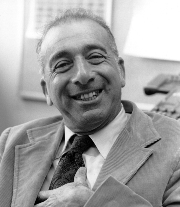Berni Alder facts for kids
Quick facts for kids
Berni Julian Alder
|
|
|---|---|
 |
|
| Born | September 9, 1925 Duisburg, Prussia
|
| Died | September 7, 2020 (aged 94) |
| Nationality | American |
| Alma mater | |
| Known for | Molecular dynamics simulation |
| Awards |
|
| Scientific career | |
| Fields | Statistical mechanics |
| Institutions |
|
| Thesis | The Radial Distribution Function and the Thermodynamic Properties of Monatomic Liquids (1952) |
| Doctoral advisor | John Gamble Kirkwood |
Berni Julian Alder (September 9, 1925 – September 7, 2020) was an American scientist born in Germany. He was a physicist who studied how tiny particles behave in large groups. He was also a leader in using computers to model how matter works.
Contents
Early Life and Education
Berni Alder was born in September 1925 in Duisburg, Germany. His parents were Jewish, and his father was a chemist. When the Nazis came to power, his family moved to Zurich, Switzerland.
With World War II starting, his family worried about safety. They got a special visa to move to the United States in 1941. They traveled through Spain and Portugal before taking a ship to the US.
After arriving in the US, Berni Alder joined the US Navy. Later, he went to the University of California at Berkeley. He earned a bachelor's degree in chemistry and a master's degree in chemical engineering in 1947.
In 1948, he went to the California Institute of Technology (Caltech) to get his PhD. There, he studied with John Gamble Kirkwood. He also worked with Stan Frankel, where he got the idea to use a special computer method called the Monte Carlo method. He finished his PhD in 1952.
A Pioneer in Computer Simulations
After finishing his studies, Berni Alder worked at Berkeley. He also became a consultant at the Lawrence Livermore National Laboratory. He helped them understand how materials behave under extreme conditions.
Developing Molecular Dynamics
In the mid-1950s, Berni Alder worked with Thomas Everett Wainwright and Mary Ann Mansigh. Together, they created new ways to use computers to simulate, or model, how molecules move. This method is called molecular dynamics simulation.
Imagine you want to know how water molecules move and interact. It's impossible to watch every single molecule in a real glass of water. But with molecular dynamics, scientists can create a computer model. This model shows how these tiny particles behave over time. This was a huge step forward for science.
Their work helped scientists understand many things. For example, they studied how liquids can turn into solids. They also looked at how fast particles move in liquids.
Teaching and Research
In 1963, Berni Alder helped start the Department of Applied Science. This department was at the University of California at Davis. He became a professor there and later a professor emeritus, meaning he was a retired professor who still had an important role.
Awards and Recognition
Berni Alder received many important awards for his work:
- In 2001, he was given the Boltzmann Medal. This award recognized his invention of the molecular dynamics simulation technique.
- In 2008, he became a Fellow of the American Academy of Arts and Sciences.
- In 2009, he received the National Medal of Science. This is one of the highest honors a scientist can get in the United States.
He was also a Guggenheim Fellow. He edited a series of books called Methods in Computational Physics. He also started a magazine called Computing.
Berni Alder passed away on September 7, 2020.

